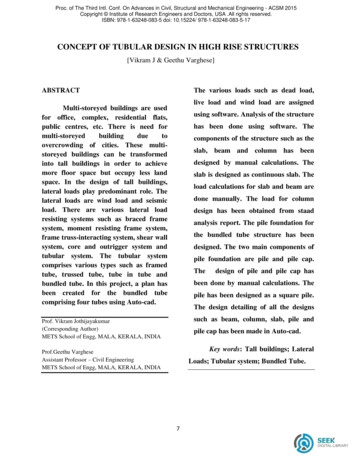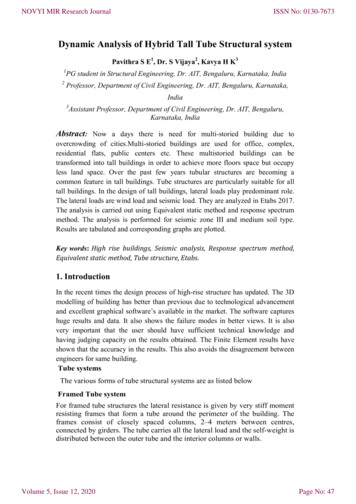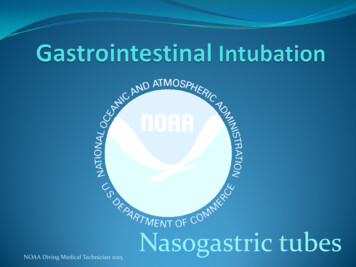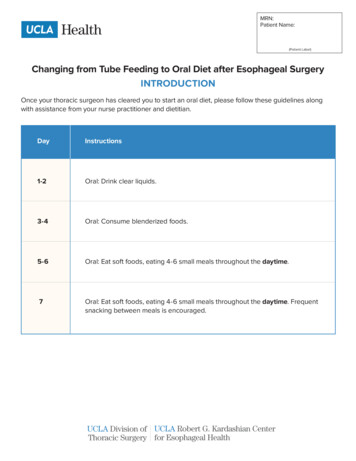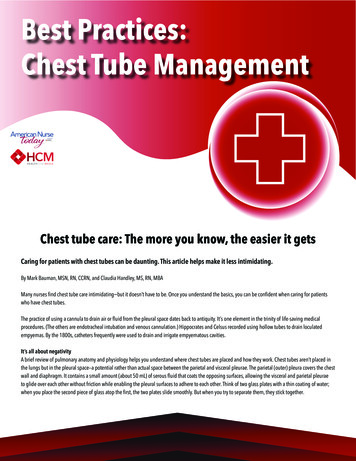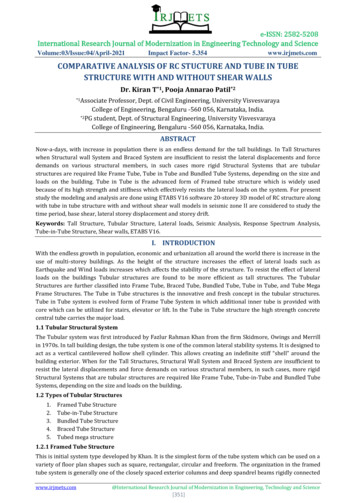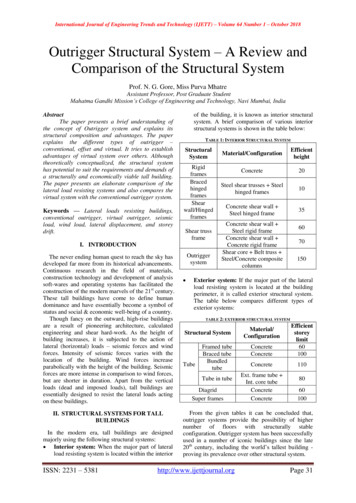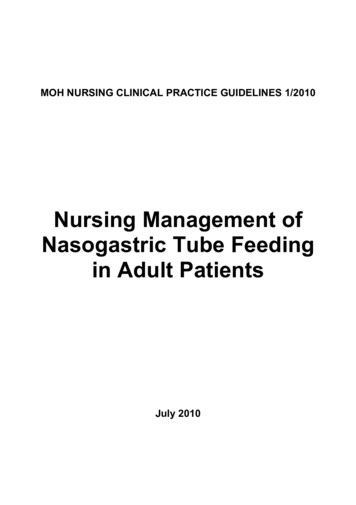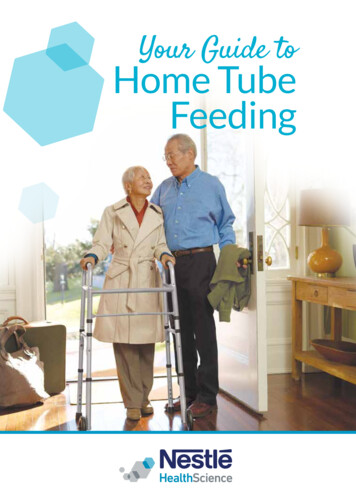
Transcription
Your Guide toHome TubeFeeding
Nestlé Health Science has made everyeffort to include in this Guide onlyinformation that it believes to be accurateand reliable as of the date of publication. ThisGuide contains information from a variety ofsources including practice based resources,guidelines from professional organizations, andexperiences of healthcare professionals who havemanaged patients on home tube feeding.Information provided in this Guide is for educationpurposes. It is not intended to replace the adviceor instruction of your healthcare professionals, orto substitute medical care. Contact a qualifiedhealthcare professional if you have anyquestions regarding your tube feedingproduct, prescription, supplies or issuesrelated to any of these.
Table ofCON T E NT SIntroduction to Tube Feeding at Home . 2The Location of Your Feeding Tube . 4Feeding Methods . 5Managing Your Tube Feeding . 6Using Syringe Feeding. 8Using Gravity Feeding. 12Using a Feeding Pump. 14Giving Water and Medication. 16Personal Care . 18Good Nutrition . 19Tube Feeding Formulas. 20Types of Formulas . 20Formula Packaging and Hang Time . 22Storing Your Formula at Home . 23Formula Intolerance. 24Problem Solving. 26Keeping a Diary. 30Your Tube Feeding Schedule. 32Your Tube Feeding Supplies. 33Contact Numbers. 34Notes. 36
Introduction toTUB E F E E D IN G AT HOM EIt’s good to be homeAs you get used to being home with your feeding tube, this Home TubeFeeding guide will help you and your family understand how to manage yourtube feeding.What is tube feeding?Tube feeding is a way of providing nutrition to people who cannot eat anddrink enough for a period of time. Tube feeding products are liquid food, often called formula, whichare given through a special tube to make sure you get thenutrition and water you need. Just like regular food, your tube feeding formula will provide allthe essential nutrients — calories, protein, carbohydrates, fats,vitamins and minerals. Your doctor may also want you to take your medication throughthe feeding tube.People may need a tube feeding for a number of reasons, such as: when unable to get enough nutrition by eating and drinking bymouth when unable to digest food normally when swallowing is difficult or unsafe after surgery or medical treatments such as radiation therapy,when it may be hard or impossible to eat for a period of timeHow this booklet can helpAs part of the training you will receive for your tube feeding at home, thisbooklet can support what your doctor, nurse and dietitian have said.2
Making your home tube feeding acomfortable experienceFor most people, tube feeding is a change that needs a certain amount oftime and persistence to get used to at home. There are ways to helpmake this adjustment easier, such as: Talk to your friends and family about your tube feeding. Ask your healthcare professional to help you arrange yourfeeding schedule so you receive your tube feeding formuladuring family meal times. If you want to take your tube feedings in private or at othertimes, be sure to keep taking part in other family andsocial activities.Talk to your healthcare professional about any questions you have aboutliving with your feeding tube at home (like bathing, exercise, or travel).What should I sayif people askabout myfeeding tube?You can answer this questionin many different ways.You may say something simple like“I am not able to eat, so this is the way I feed myself.”Or if you are having medical treatments orproblems swallowing or digesting food you might say“I am having trouble swallowing and need to get my food this way.”“I am having medical treatments which make it hard to eat. I use this feedingtube to get the nutrition I need.”“My stomach/gut is not working properly, so I need this tubeto feed myself.”“My body has a hard time digesting foods. I use thisfeeding tube and special liquid food to get thenutrition I need.”3
The Location ofY OU R F E E D IN G T U B EWhere is the feeding tube in my body?There are many different types of feeding tubes used to give tube feedingformula. And there are several different places where these feeding tubesmay be located in the body. Each of these places allows the nutrients in theformula to be used by your body, just like eating a regular meal: Nasogastric or ‘NG-Tube’: The feeding tube goes through thenose, down the esophagus or food tube, and ends in the stomach. Nasojejunal or ‘NJ-Tube’: The feeding tube goes through thenose, down the esophagus or food tube, continues through thestomach, and ends in the small intestine. Gastrostomy or ‘G-Tube’: The feeding tube goes through a smallopening in the skin directly into the stomach. Jejunostomy or ‘J-Tube’: The feeding tube goes through a smallopening in the skin into the jejunum or small intestine.Yourfeeding tube is atube.esophagusstomachsmall intestinelarge intestine4
FeedingMETHO D SThere are different ways to provide a tubefeeding.Tube Feedings may be timed or planned to be: Continuous: formula is flowing allthe time or for many hours duringthe day and/or nightA feeding pumpis a special devicethat controls thetiming and amountof formula given.Formula flows froma feeding bag orpre-filled containerthrough tubing thatruns into the pumpand then intoyour feeding tube. Intermittent or Bolus: formula isgiven at meal times or with breaksduring the day or a mix of these twoGravity feedingDepending on the tube feeding plan, theformula may be delivered by:uses a feeding bagand tubing whichyou hang on a poleabove the level ofyour stomach.Gravity will movethe formula fromthe bag throughyour feeding tube. A feeding pump (for continuousfeeding and some intermittentfeedings) Gravity (for intermittent feedings) Syringe (for bolus feeding)A feeding method (the timing and delivery)may be chosen because of: The type and location of thefeeding tube you have The reason you need the tubefeeding How often you need tube feeding How you manage your tubefeeding at homeYour healthcare team has chosen themethod they believe will work best for youat home to make sure you get the nutritionyou need.Syringe feedinguses a large syringe todeliver the formula.The formula can begently pushed intoyour feeding tubeusing the syringeplunger or it can flowfrom the syringe intoyour feeding tubeusing gravity.5
The following section, Managing your TubeFeeding, will cover the different feedingdelivery methods and the equipment needed.ManagingYO U R T U B E FEED INGChecking the placement ofyour feeding tube(If instructed by your healthcare professional)You may be asked to check the placement of your feeding tube athome before you start a feeding - or less often (once a day or a fewtimes a week).If you have been asked to check the position of your tube,follow these steps:1. Wash your hands.2. For a nasogastric or nasojejunal tube: check the proper tubeposition as instructed by your healthcare professional (theremay be a special mark drawn on the tube or a certain lengthit should be from the end of your nose).For a gastrostomy or jejunostomy tube: use a ruler ornon-stretchy tape measure to measure the number ofinches/centimetres from the spot where your tube exits yourskin to the end of the tube (as pictured).3. Compare the number with previous measurements. If thereis more than centimetre(s) /inch(es) difference, callyour healthcare professional.Do not begin the next feeding.6
7
Using syringe feedingGather your supplies Formula Clean cup or container (if needed) 60 mL syringe Water (room temperature)Get set up1. Wash your hands2. Wipe the top of the formula container with aclean, wet cloth3. Shake the formula container gently4. Check your ‘feeding schedule’ for how muchformula to useStarting the feeding1. Get in a comfortable position – sit upright or lie withthe head of your bed raised to 45 degrees (about theheight of 3 pillows)2. Open your feeding tube Fold over and pinch or clamp the end of your feedingtube to stop the flow. Then uncap the tube.3. Flush your feeding tube with mL of water4. Close or recap your feeding tubeFor the next steps, continue to page 108
9
Use either Method A or B:M ETHO D APOUR I NG FORM U LA I NTO T H E S Y R IN G E5.Open your feeding tube Fold over and pinch or clamp the end of your feeding tube to stopthe flow. Then uncap the tube.6.Attach the syringe to the end of your feeding tube. Unfold your tubeto start the flow.7.Pour your formula into the syringe8.Let the formula flow into your tube by gravity9.Continue refilling the syringe until your entire feeding is given This entire process may take a few minutes or you may space outthe syringe feeding over a longer period of time Talk to your healthcare professional about how long your tubefeeding should take10Take the syringe off your tube – fold over and pinch the end ofyour feeding tube to stop the flow and recap the tube11. After feeding, flush your feeding tube with mL of water12. Close or recap your feeding tube13. Clean, rinse and dry your supplies10
M ET H O D BD R AWING TH E FORM U LA I N TO T H E S Y R IN G EF ROM A CUP OR C ONTA I N E R5.Pour your formula into a clean cup or container6.Draw the formula up into the syringe7.Open your feeding tube Fold over and pinch or clamp the end of your feeding tube to stopthe flow, then uncap the tube8.Attach the syringe to the end of your feeding tube9.Gently push the formula into your tube with the syringe plunger10. Take the syringe off your tube – fold over and pinch or clampthe end of your feeding tube to stop the flow and recap the tube11. Repeat steps 6 to 10 until your entire feeding is given This entire process may take a few minutes or you may space outthe syringe feeding over a longer period of time Talk to your healthcare professional about how long your tubefeeding should take12. After feeding, flush your feeding tube with mL of water13. Close or recap your feeding tube14. Clean, rinse and dry your supplies11
Using Gravity FeedingGather your supplies Formula Feeding bag and tubing Pole 60 mL syringe Water (room temperature)Get set up1. Wash your hands2. Wipe the top of the formula container with a clean,wet cloth3. Shake the formula container gently. If using a pre-filled formula container, shake the containerand spike it with the feeding set as shown by yourhealthcare professional – then go to step 64. Close the tubing on the feeding bag by closing theside/roller clamp5. Pour the formula into the feeding bag and close the topof the bag Check your ‘feeding schedule’ for how muchformula to use6. Hang the feeding bag on the pole so it is at least 18 inches /45 centimetres above the level of your stomach7. Start the flow of formula through the feeding bag tubing byopening the side/roller clamp8. Let the formula flow to the tip of the tubing9. Close the side/roller clamp12
Starting the feeding1. Open your feeding tube Fold over and pinch or clamp the end of your feeding tube to stopthe flow. Then uncap the tube.2. Flush your feeding tube with mL of water3. Attach the tip on the end of the feeding bag tubing to yourfeeding tube4. Get in a comfortable position – sit upright or lie with the headof your bed raised to 45 degrees (about the height of 3 pillows)5. Open the side/roller clamp to adjust the flow rateto drips or mL per seconds6. Each feeding should take about minutes7. After the feeding, close and take off the feeding bag tube You may be asked to pour mL of water into your feeding bagand run this into your body before taking off the feeding bag tube8. Flush your feeding tube with mL of water9. Close your feeding tube10. Clean, rinse and dry your supplies11. Replace your feeding container and tubing asadvised by your healthcare professional13
Using a Feeding PumpGather your supplies Formula Feeding bag and tubing Feeding pump Pole 60 mL syringe Water (roomtemperature)Get set up1. Wash your hands2. Wipe the top ofthe formulacontainer with aclean, wet cloth3. Shake the formulacontainer gently If you are using a pre-filledformula container, shake thecontainer and spike it with the feeding set as shown by yourhealthcare professional – then go to step 54. Pour the formula into the feeding bag and close the top of the bag –make sure the side/roller clamp is closed Check your ‘feeding schedule’ for how much formula to use5. If using an IV pole, hang the feeding bag on the pole above thefeeding pump6. Since every pump is different, follow the instructions given by yourhealthcare professional to use your feeding pump and ‘prime’ thetubing (‘priming’ means to fill the tubing with formula before it isattached to your feeding tube)14
Starting the feeding1. Get in a comfortable position – sit upright or lie with thehead of your bed raised to 45 degrees (about the height of3 pillows)2. Open your feeding tube Fold over and pinch or clamp the end of your feedingtube to stop the flow. Then uncap the tube.3. Flush your tube with mL of water4. Attach the tip on the end of the feeding bag tubing to yourfeeding tube5. Set the flow rate on the pump to mL per hour6. If needed, open the side/roller clamp on the feeding bagtube7. Start your feeding pump8. After the feeding, take the feeding bag tube off of yourfeeding tube9. Flush your tube with mL of water10. Close your feeding tube11. Clean, rinse and dry your supplies If you are using a pre-filled formula container, throw thecontainer away when it is empty If you are pouring formula into a feeding bag containerfor your tube feeding, check with your healthcareprofessional about how long your feeding formula should“hang” or stay in the feeding bag and tubing at roomtemperature12. Replace your feeding container and tubing as advised byyour healthcare professional15
How to Give Water or MedicationsWIT H A S YRINGEWater is part of your formula, but extra water and sometimesmedications are needed to keep your body healthy and your feedingtube working well. Your healthcare professional will tell you how much water ormedication to take. Your healthcare professional will tell you whichmedications you can crush, or if there are liquidmedications you can take.Check with your nurse, doctor orpharmacist to find out about: Which medications should not be crushed How to crush medications – if you are asked to do this How much water to mix with your medication Which medications should not be given together If there are any other special instructions about giving yourmedications through your feeding tube16
When giving water andmedications, follow the steps below.When giving water only, start at step 2.1. Using a 60 mL syringe, flush yourfeeding tube with 15-30 mL of warmwater before giving medication(unless you are told something differentby your healthcare professional). SeeFigure 1.fig. 12. Using a 60 mL syringe, draw up the rightdose of medication or water into thesyringe. Open your feeding tube andattach the syringe to your feeding tube.See Figure 2 and Figure 3.fig. 23. Gently push the water or medicationinto your tube. See Figure 3.4. Take the syringe off your feeding tubeand refill the syringe with warm wateruntil the all of the water you need isgiven, or to flush all the medication outof the syringe.fig. 35. Close your feeding tube when finishedand place the cap back on the tip of thesyringe.17
PERS ONA L C AR EYour mouthKeeping your mouth clean is important when tube feeding, even if youare not eating and drinking. Your healthcare professional mayrecommend you brush your teeth each day and use lip balm to helpkeep your lips moist.Ask about the best way to keep your mouth clean and which productsyou should use.Follow the advice from your healthcare professional.InstructionsYour noseIf you are taking your feeding through a nasogastric tube, the tubepassing through your nose may cause mild irritation or you may noticesome thick, crusty mucus in your nose.Ask about the best way to take care of your nose.Follow the advice from your healthcare professional.InstructionsYour tube siteIf you have a gastrostomy or jejunostomy tube, taking care of the skinaround the area where the tube enters your body is very important.Ask about the best way to take care of your tube site.Follow the advice from your healthcare professional.Instructions18
GOOD NU T RIT IO NA healthy diet is more than just “food” – it provides fuel as well asthe building blocks to keep or restore health and to help withhealing.Maintaining a healthy diet and good nutrition is important foreveryone, but is crucial to the person who has an illness, is receivingcertain medical treatments, recovering from surgery, or has hadunwanted weight loss. Your body may be working extra hard torestore good health, and this may increase your nutrient needs.The nutrients needed by the body include: carbohydrates vitamins protein minerals fat waterThese nutrients work together to maintain and build body tissueand provide energy for your body. Normally, these nutrients areprovided by eating a variety of foods. However, because of yourspecial needs, you are getting your nutrition in a liquid formthrough a tube.19
TUB E F E E D IN G FOR M U LASThere are a wide range of tube feeding formulas which may come indifferent types of packaging. Your healthcare professional will consideryour unique needs when choosing a formula – this includes not only yournutrition needs but also the feeding method you are using at home.Types of FormulasStandard FormulasStandard formulas are nutritionally complete and are designed forpeople who have normal digestion. Some of these formulas can be usedfor both tube-feeding and oral feeding, and some contain additionalingredients, such as fibre.There are also formulas available which contain real food ingredientssuch as chicken, vegetables and fruit along with other vitamins andminerals to create a nutritionally complete formula.Isosource, Nutren and Compleat are examples of standard formulas.20
Semi-elemental/Peptide-based FormulasLike standard formulas, semi-elemental formulas arenutritionally complete. Semi-elemental formulas aredifferent because they contain some nutrients, likeprotein and fat, which are ‘broken down’ into smallerunits to make them easier to digest. This is the reasonthese formulas are also called “peptide-based” formulas– because “peptides” is the name used to describesmaller units of protein. Some semi-elemental/peptide-based formulas can also be used for bothtube-feeding and oral feeding, and some containingredients, such as fibre and fish oils.Peptamen is an example of asemi-elemental/peptide-based formula.Specialized FormulasSpecialized formulas are available for people with particular needs such askidney or liver disease, Crohn’s disease, diabetes or those with severetrouble digesting fat and protein.Novasource, Modulen and Vivonexare examples of specialized formulas.21
FOR MU L A P ACKAGINGTube feeding formulas come in different types of packages. Sometimes theterms “open system” and “closed system” are used to describe how theformula is packaged and delivered.Open system formulasPACKAGING Ready-to-use liquids in ‘drink box’ packaging,bottles, or cans A powder that is mixed with waterDELIVERY All of these ‘open system’ formulas are fed using either a syringe orcontainer that the formula is poured into before feedingClosed system formulasPACKAGING Pre-filled containers or pouchesDELIVERY The container is ‘spiked’ or pierced with aspecial tubing set before feedingF ORM UL A H A N G TIMEThe term “formula hang time” refers to how long a tube feeding formulashould remain at room temperature for feeding – after the formula packagehas been opened or the original package seal has been broken.Open system formulas Up to 8 hours* for ready-to-use liquids Up to 4 hours* for powders that have been mixed with waterClosed system formulas Up to 24-48 hours**Important Note: always check with your healthcare professional about theformula hang time for your tube feeding formula.22
Storing Your Formula A T HOM EStoring your Formula at HomeThe following information is a general guide. The formula package oryour healthcare professional may provide other instructions for yourparticular formula.Liquid Formulas Packages that have not been openedcan be stored at room temperature. Once a formula package is opened itshould be used right away ORcovered and stored in therefrigerator. Use it within24 hours. If not used in 24 hours,throw it away.Should I shake liquidfeeding formulabefore using?Yes. Always gently shakeunopened liquid formulapackages before using.Powdered Formulas Store powdered formula in a cool,dry place. Check the package to see howlong to keep the powderedformula after it is opened.Check the expiry date on yourformula. Throw away formula thatis past its expiry date.Do I need torefrigerate my formulabefore feeding?Will using cold formulaupset my stomach?Cold formula may upset yourstomach. You can takerefrigerated formula out ofthe refrigerator for 30minutes to slowly warm up toroom temperature beforefeeding.No. Most often, tube feedingformula is stored and used atroom temperature.If a liquid formula package isopened and not used right away,it should be kept in therefrigerator for up to 24 hours.23
Feeding INT O L ER ANCEWhen you first start a tube feeding, it may take a few days for yourbody to adjust to the formula and feeding routine. But there are times,when you simply may not tolerate the feeding formula you have beenasked to use – you may feel unwell and cannot take all of your formulaeach day. This can become a problem if you are not able to get thenutrition and water you need, or if you are having unpleasantsymptoms that make you feel unwell.Feeding intolerance is often talked about by the signs or symptomspeople have – which may vary from feeling full and having a swollenbelly (abdomen) to vomiting or diarrhea. Being on a tube feeding doesnot mean that you should feel uncomfortable during or after you takeyour formula.24
I N TOL E RA NC E C HECKLIS TTube Feeding Intolerance ChecklistYou can use the checklist below to help see if you may be suffering fromtube feeding intolerance.Check the items below that tell how you are feeling. It helps to add notes tobetter describe how often the symptom(s) occur and how long they last.Check all that applyNotes on severity, frequencyand durationNausea(feeling sick to your stomach)VomitingReflux (feeling like your stomachcontents are coming back up inyour throat)Feeling ofFullnessBloating or swollenbelly/abdomenDiarrhea/loose stoolsConstipationFeedings are being stopped or youneed to slow down the rate offeedings because you feel unwellIf you checked one or more of the above, you may have tube feedingintolerance.Talk to your healthcare professional about how to manage these symptomsand if there may be another feeding formula to help make your feedingseasier and more comfortable.You may also find ideas in the next section on ‘Problem Solving’ to helpmanage your tube feeding at home.25
Problem S OL V IN GWhen Things do not Seem RightSometimes you may experience problems when tube feeding. The table on thenext few pages provides information about some of the more commonproblems, possible causes and some steps you may take. The informationprovided in this table is not intended to replace the advice or instruction of yourhealthcare professionals, or to substitute medical care. If you have a problem,or have more questions, be sure to talk to your healthcare professional.26PROBLEMPOSSIBLE CAUSEWHAT TO THINK ABOUTNauseaand/orVomitingand/orReflux(feeling likeyourstomachcontentsare comingback upinto yourthroat) Feeding too quickly Slow digestion inthe stomach Other stomach/digestive problemsor illness Slow or stop the feed until you arecomfortable. If needed, delay thenext feeding by 15-20 minutes andrestart slowly.* Slow down feed rate* Sit upright or lie at a 45-degreeangle (about the height of threepillows) during the feeding and for30 to 60 minutes after the feeding.Do not lie flat during or just after afeeding. Check with your healthcareprofessional to see if you shouldchange to a special formula thatmay be easier to digest and absorb Speak to your healthcareprofessional if this problemcontinuesDiarrhea(frequent,loose,watery orliquidstools) Medication sideeffects Formula is beingfed too fast Talk to your doctor or pharmacistabout your medications Slow down the feeding rate* Do not use formula that has beenopened and left at roomtemperature for longer thanrecommended on the formulalabel Do not use formula that has beenopened and left in the fridge forlonger than 24 hours Wash your hands well, and useclean supplies/equipment Replace your feeding containerand tubing as directed by yourhealthcare professionalContinues on next page
PROBLEMPOSSIBLE CAUSEWHAT TO THINK ABOUTContinued fromprevious pageDiarrhea(frequent,loose,watery orliquidstools) No fibre, or notenough fibre, inyour formula Intolerance to theformula You may haveanother illness, fluor infection Your feeding tubemay have movedout of place Check with your healthcareprofessional about changing toa formula that has fibre Check with your healthcareprofessional to see if you shouldchange to a special formula thatmay be easier to digest andabsorb. Speak to your healthcareprofessional if this problemcontinues for more than 2 eeling offullness Formula is beingfed too fast Formula is too cold Too much formula Lying flat whiletaking the feeding Exercising or toomuch activity rightafter a feeding Intolerance to theformula Slow down the feeding rate* Use stored, unopenedformula at roomtemperature for feedings. Ifyou have opened formula inthe refrigerator, remove for30 minutes before feeding. Make sure you are takingthe right amount of formulaand/or feeding rate Sit upright or lie at a45-degree angle (about theheight of three pillows)during the feeding and for30 to 60 minutes after thefeeding. Do not lie flatduring or just after a feeding. Ask your healthcareprofessional to review yourformula. You may need toswitch to a formula that hasmore calories in less volumeor to a special formula thatmay be easier to digest andabsorb.* If you have slowed your formula flow rate this may reduce the amount of formula,water and nutrition you are getting. Check with your healthcare professional if you arenot able to return to your original rate after 1 or 2 days and you are unable to get theamount of formula and water indicated in your feeding schedule.27
28PROBLEMPOSSIBLE CAUSEWHAT TO THINK ABOUTConstipation(bowelmovementsoccur lessthan usualor are hard,dry andpainful ordifficult topass) You are nottaking enoughfluid or water No fibre, or notenough fibre, inyour formula Not enoughexercise oractivity Medications Take more water through yourfeeding tube if advised by yourhealthcare professional Check with your doctor ordietitian to see if you shouldchange to a formula that containsenough fibre Be more active - if this is possible(check with your doctor) Talk to your doctor or pharmacistabout your medicationsDehydration(the amountof water inthe body hasdroppedbelow thelevel neededfor normalbodyfunction);Passing lessurine/darkyellowurine;Feelingthirsty You are nottaking enoughfluid or water Illness withdiarrhea, fever,heavy sweating Make sure you are taking the rightamount of water every day beforeand after your feedings Talk to your healthcareprofessional to make sure you aregetting the right amount of watereach dayGainingweightquickly(more than5 pounds or2 kg aweek) You may begetting too muchfluid or water You may begetting too muchformula Make sure you are taking the rightamount of formula and waterevery day Talk to your healthcareprofessional to see if you need tochange the amount of formula andwater each dayLosingweight You may not begetting enoughcalories Make sure you are taking the rightamount of formula every day Talk to your healthcareprofessional to see if you need tochange the amount or type offormula you are taking
PROBLEMPOSSIBLE CAUSEWHAT TO THINK ABOUTAspiration(brea
problems swallowing or digesting food you might say "I am having trouble swallowing and need to get my food this way." "I am having medical treatments which make it hard to eat. I use this feeding tube to get the nutrition I need." "My stomach/gut is not working properly, so I need this tube to feed myself."
